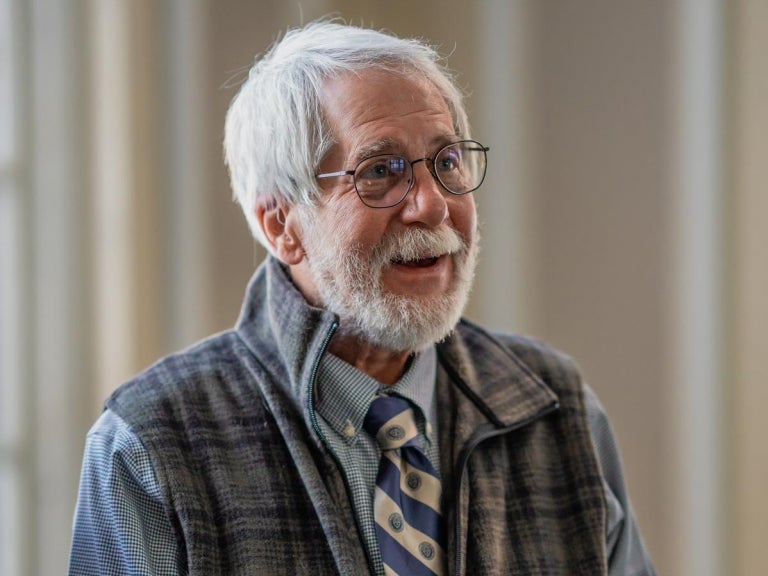
Professor Emeritus George Carvell has been a member of the Department of Physical Therapy faculty at the University of Pittsburgh for 47 years. When he retired in 2022, he was not content to sit back and relax—instead, he published his book Gray Matter On My Mind: Brains Wired For Survival and Success. It was a process that took him over two decades to complete.
Carvell found his passion for science at a young age. “When I was in eighth grade, the U.S.-Soviet race for space was beginning, so there was a sudden push for STEM programs,” he explains. “My eighth-grade science teacher inspired my love for the subject. I have always admired nature and have always tried to figure out how things, animate and inanimate, work. That has stayed with me for my whole life.” His fascination with the human body started in high school and he majored in biology at Gettysburg College. Following graduation, he taught science to eighth graders, who were not always interested or engaged. “I found out that for some of these kids, science and eighth grade is an oxymoron,” he quips, “I don’t recommend teaching science to eighth graders.” He decided to leave his teaching position and began his studies in physical therapy at the University of Pennsylvania. He had his first official neuroscience and neurology courses, and he was hooked.
After practicing PT for a number of years and pursuing his Master in Medical Science at Emory University, Carvell found himself at the University of Pittsburgh. He began teaching in Pitt’s Department of Physical Therapy and enrolled in the Department of Neurobiology, Anatomy and Cell Science as a PhD student while working as an instructor full-time. His research then, and continuing until his retirement, was related to anatomy, physiology and behavior of rats using their whiskers to relay touch information to the circuitry in their brains. “The coolest thing about my research is the ability to see and hear neurons chattering during an electrophysiological study of a rat’s brain,” Carvell exclaims, “Some people think I’m a little weird for this passion.”
His favorite thing about teaching neuroscience is when he can explain a difficult concept to his students, and they actually seem to know what he’s talking about. This is what inspired him to write a book on how to teach neuroscience to people with little to no formal background on the subject. “I would like individuals, whether they be students, clinicians, researchers or lay readers who are just curious about how the brain may work, to read this book and hopefully learn something new and interesting about the very organ they use to learn,” says Carvell. He uses humor throughout his writing to keep the reader engaged in the oftentimes dry material.
Carvell started his journey to publication in the 1990s. “Writing this book was a long, arduous and sometimes bumpy road for me. I have gone through probably a hundred different drafts and I kept adding more material and editing and editing some more,” he explains, “There were many times when I told myself this was not worth all the time and effort, but when I could see a final product that was actually working, the time and effort was then worthwhile.” Finally, after 23 years of failing to reach an agreement with a publisher, he decided to publish it through Creative Commons as an Open Access eBook. “It is unlikely there will be a second edition if it takes me another 23 years to get it ready,” he jokes.
Professor Carvell wanted to share his favorite passage from the first chapter of GMOMM:
“Scientists by their very nature are inquisitive people who typically see science as more of a matter of formulating testable questions to advance our understanding rather than providing a final answer to complex phenomena in nature (truth). More often than not, research findings lead to incomplete answers that, in turn, provide more refined questions and new approaches. Dedicated scientists and clinician-scholars have repeated “scratch your head-what does that mean?” moments in the laboratory or clinic. If the scientist scratches her head but then does nothing, that will not lead to progress. If the head-scratching leads to action, progress may be made. On the other hand, if she scratches someone else’s head without permission,she may become quite unpopular.
Science is the intellectual “itch” that keeps on returning to the curious. The cure is not a lotion or potion but is the scientist’s incentive driving that curious individual to take demonstrative action and to persevere in the face of daunting challenges, both intellectual and fiscal.” Page 39, Gray Matter On My Mind: Brains Wired For Survival and Success, George E. Carvell, PhD, PT University of Pittsburgh© 1999-2022.
His book is currently available as an Open Access eBook —you can read more here!
